Exploring Ethical Dilemmas in Nursing: A Case Study Analysis
VerifiedAdded on 2022/11/18
|9
|2457
|401
Essay
AI Summary
This essay delves into the realm of nursing ethics, examining the complexities and challenges faced by nurses in their daily practice. The core of the analysis revolves around a case study featuring a registered nurse, Rob, and his patient, Jack, who is also his neighbor. The ethical dilemma arises from Jack's request to join Rob for lunch, presenting a conflict between professional boundaries, patient care, and personal relationships. The essay explores the positive aspects of accepting Jack's request, such as fostering a patient-centered approach and building a stronger nurse-patient bond, while also acknowledging the potential negative implications related to professional conduct and maintaining the patient's privacy and confidentiality. The MORAL model of ethical decision-making is applied to address the dilemma, offering a structured approach to resolving ethical conflicts. The essay underscores the importance of adhering to the code of conduct, differentiating between personal and professional life, and making ethical considerations before making any decision, emphasizing the need for nurses to guide patients toward healthier lifestyles and maintain ethical standards.
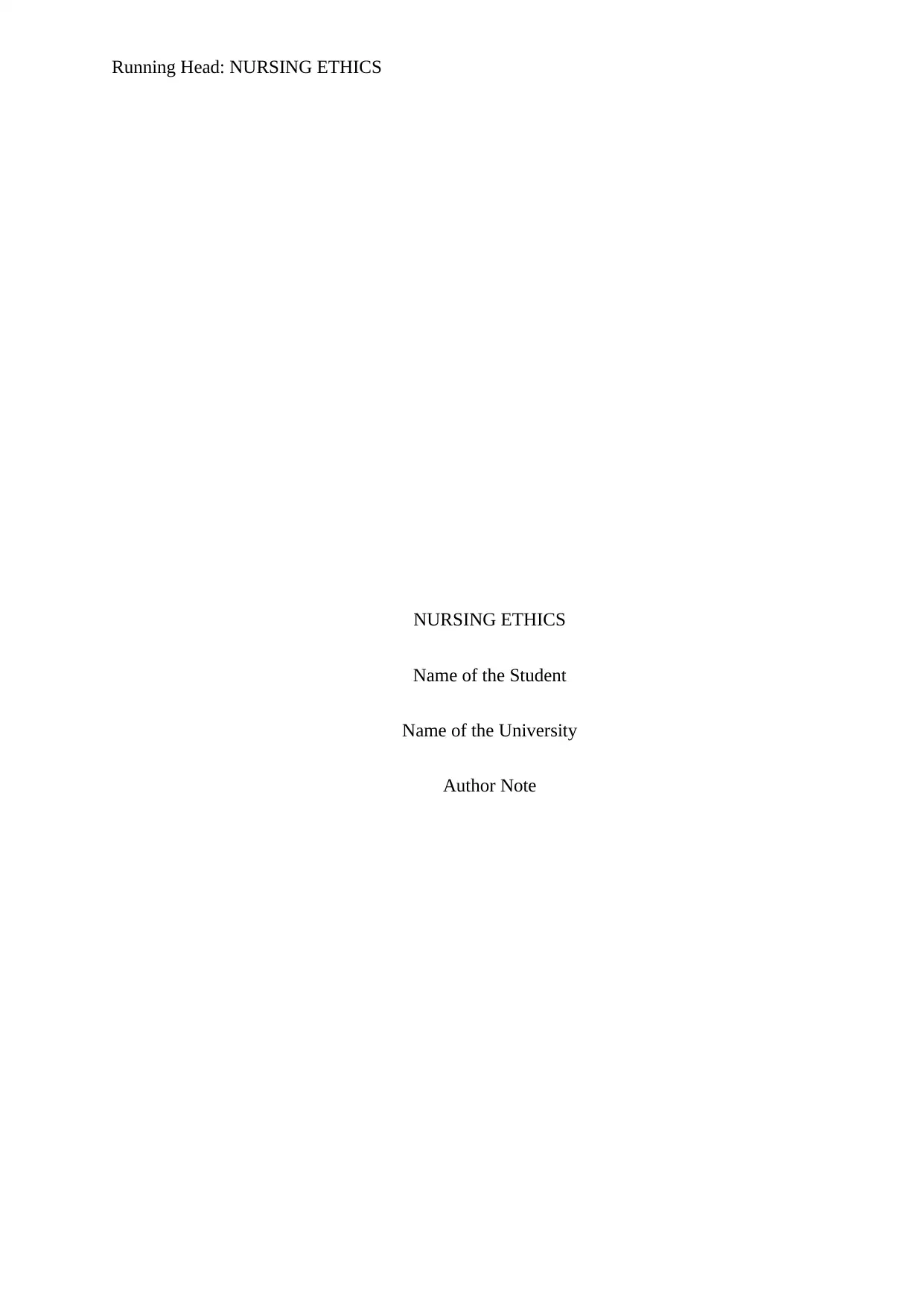
Running Head: NURSING ETHICS
NURSING ETHICS
Name of the Student
Name of the University
Author Note
NURSING ETHICS
Name of the Student
Name of the University
Author Note
Paraphrase This Document
Need a fresh take? Get an instant paraphrase of this document with our AI Paraphraser
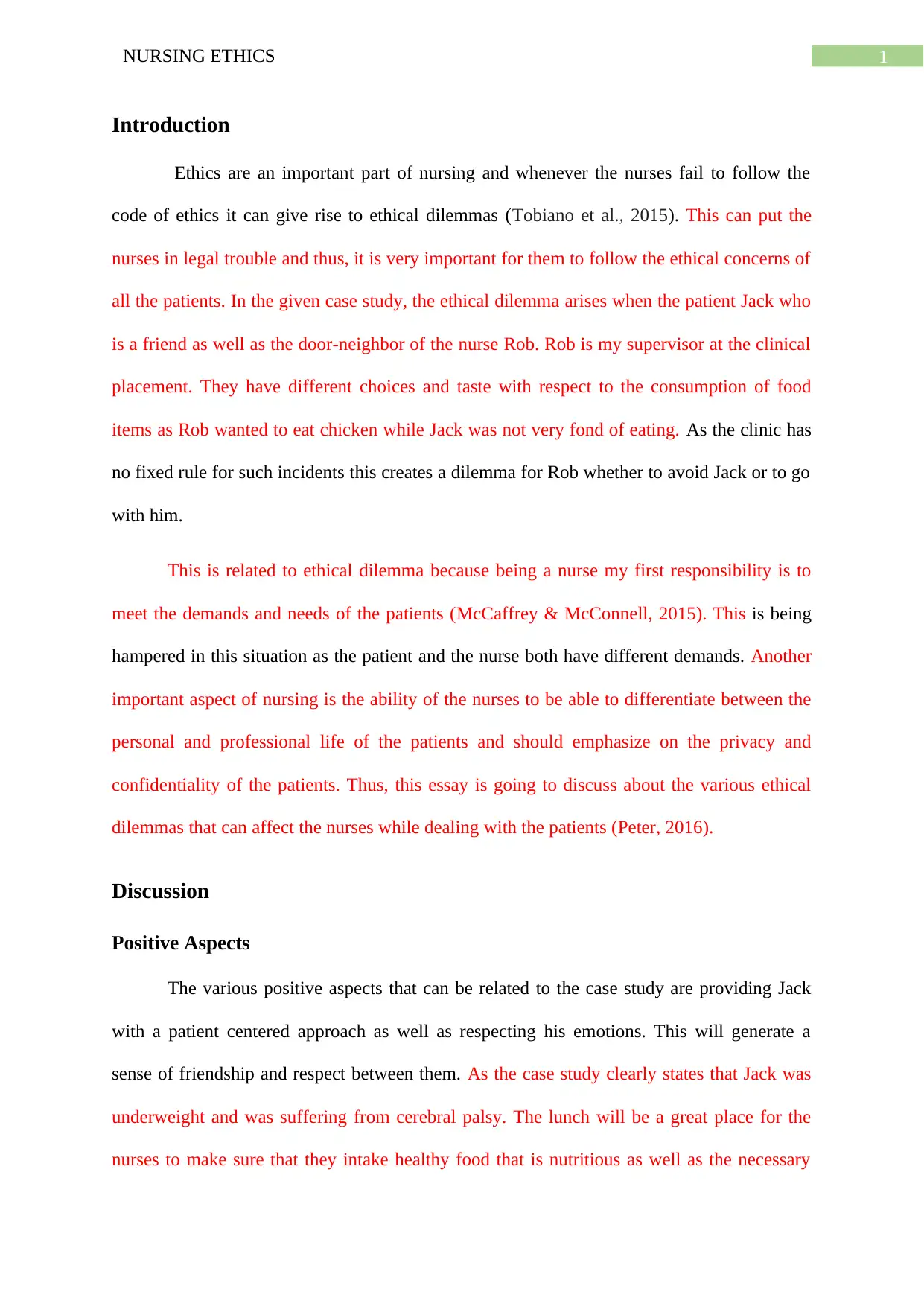
1NURSING ETHICS
Introduction
Ethics are an important part of nursing and whenever the nurses fail to follow the
code of ethics it can give rise to ethical dilemmas (Tobiano et al., 2015). This can put the
nurses in legal trouble and thus, it is very important for them to follow the ethical concerns of
all the patients. In the given case study, the ethical dilemma arises when the patient Jack who
is a friend as well as the door-neighbor of the nurse Rob. Rob is my supervisor at the clinical
placement. They have different choices and taste with respect to the consumption of food
items as Rob wanted to eat chicken while Jack was not very fond of eating. As the clinic has
no fixed rule for such incidents this creates a dilemma for Rob whether to avoid Jack or to go
with him.
This is related to ethical dilemma because being a nurse my first responsibility is to
meet the demands and needs of the patients (McCaffrey & McConnell, 2015). This is being
hampered in this situation as the patient and the nurse both have different demands. Another
important aspect of nursing is the ability of the nurses to be able to differentiate between the
personal and professional life of the patients and should emphasize on the privacy and
confidentiality of the patients. Thus, this essay is going to discuss about the various ethical
dilemmas that can affect the nurses while dealing with the patients (Peter, 2016).
Discussion
Positive Aspects
The various positive aspects that can be related to the case study are providing Jack
with a patient centered approach as well as respecting his emotions. This will generate a
sense of friendship and respect between them. As the case study clearly states that Jack was
underweight and was suffering from cerebral palsy. The lunch will be a great place for the
nurses to make sure that they intake healthy food that is nutritious as well as the necessary
Introduction
Ethics are an important part of nursing and whenever the nurses fail to follow the
code of ethics it can give rise to ethical dilemmas (Tobiano et al., 2015). This can put the
nurses in legal trouble and thus, it is very important for them to follow the ethical concerns of
all the patients. In the given case study, the ethical dilemma arises when the patient Jack who
is a friend as well as the door-neighbor of the nurse Rob. Rob is my supervisor at the clinical
placement. They have different choices and taste with respect to the consumption of food
items as Rob wanted to eat chicken while Jack was not very fond of eating. As the clinic has
no fixed rule for such incidents this creates a dilemma for Rob whether to avoid Jack or to go
with him.
This is related to ethical dilemma because being a nurse my first responsibility is to
meet the demands and needs of the patients (McCaffrey & McConnell, 2015). This is being
hampered in this situation as the patient and the nurse both have different demands. Another
important aspect of nursing is the ability of the nurses to be able to differentiate between the
personal and professional life of the patients and should emphasize on the privacy and
confidentiality of the patients. Thus, this essay is going to discuss about the various ethical
dilemmas that can affect the nurses while dealing with the patients (Peter, 2016).
Discussion
Positive Aspects
The various positive aspects that can be related to the case study are providing Jack
with a patient centered approach as well as respecting his emotions. This will generate a
sense of friendship and respect between them. As the case study clearly states that Jack was
underweight and was suffering from cerebral palsy. The lunch will be a great place for the
nurses to make sure that they intake healthy food that is nutritious as well as the necessary
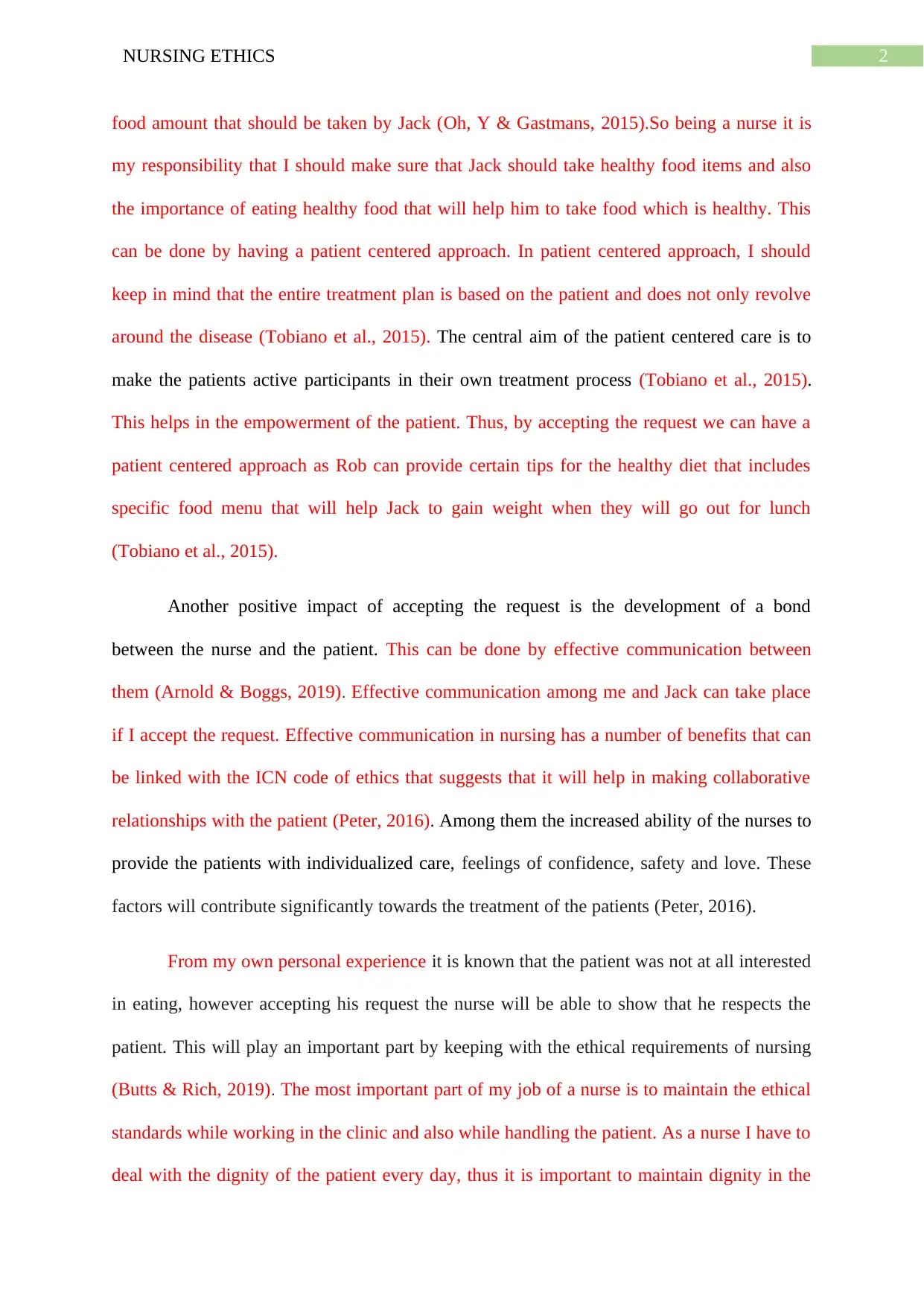
2NURSING ETHICS
food amount that should be taken by Jack (Oh, Y & Gastmans, 2015).So being a nurse it is
my responsibility that I should make sure that Jack should take healthy food items and also
the importance of eating healthy food that will help him to take food which is healthy. This
can be done by having a patient centered approach. In patient centered approach, I should
keep in mind that the entire treatment plan is based on the patient and does not only revolve
around the disease (Tobiano et al., 2015). The central aim of the patient centered care is to
make the patients active participants in their own treatment process (Tobiano et al., 2015).
This helps in the empowerment of the patient. Thus, by accepting the request we can have a
patient centered approach as Rob can provide certain tips for the healthy diet that includes
specific food menu that will help Jack to gain weight when they will go out for lunch
(Tobiano et al., 2015).
Another positive impact of accepting the request is the development of a bond
between the nurse and the patient. This can be done by effective communication between
them (Arnold & Boggs, 2019). Effective communication among me and Jack can take place
if I accept the request. Effective communication in nursing has a number of benefits that can
be linked with the ICN code of ethics that suggests that it will help in making collaborative
relationships with the patient (Peter, 2016). Among them the increased ability of the nurses to
provide the patients with individualized care, feelings of confidence, safety and love. These
factors will contribute significantly towards the treatment of the patients (Peter, 2016).
From my own personal experience it is known that the patient was not at all interested
in eating, however accepting his request the nurse will be able to show that he respects the
patient. This will play an important part by keeping with the ethical requirements of nursing
(Butts & Rich, 2019). The most important part of my job of a nurse is to maintain the ethical
standards while working in the clinic and also while handling the patient. As a nurse I have to
deal with the dignity of the patient every day, thus it is important to maintain dignity in the
food amount that should be taken by Jack (Oh, Y & Gastmans, 2015).So being a nurse it is
my responsibility that I should make sure that Jack should take healthy food items and also
the importance of eating healthy food that will help him to take food which is healthy. This
can be done by having a patient centered approach. In patient centered approach, I should
keep in mind that the entire treatment plan is based on the patient and does not only revolve
around the disease (Tobiano et al., 2015). The central aim of the patient centered care is to
make the patients active participants in their own treatment process (Tobiano et al., 2015).
This helps in the empowerment of the patient. Thus, by accepting the request we can have a
patient centered approach as Rob can provide certain tips for the healthy diet that includes
specific food menu that will help Jack to gain weight when they will go out for lunch
(Tobiano et al., 2015).
Another positive impact of accepting the request is the development of a bond
between the nurse and the patient. This can be done by effective communication between
them (Arnold & Boggs, 2019). Effective communication among me and Jack can take place
if I accept the request. Effective communication in nursing has a number of benefits that can
be linked with the ICN code of ethics that suggests that it will help in making collaborative
relationships with the patient (Peter, 2016). Among them the increased ability of the nurses to
provide the patients with individualized care, feelings of confidence, safety and love. These
factors will contribute significantly towards the treatment of the patients (Peter, 2016).
From my own personal experience it is known that the patient was not at all interested
in eating, however accepting his request the nurse will be able to show that he respects the
patient. This will play an important part by keeping with the ethical requirements of nursing
(Butts & Rich, 2019). The most important part of my job of a nurse is to maintain the ethical
standards while working in the clinic and also while handling the patient. As a nurse I have to
deal with the dignity of the patient every day, thus it is important to maintain dignity in the
⊘ This is a preview!⊘
Do you want full access?
Subscribe today to unlock all pages.

Trusted by 1+ million students worldwide
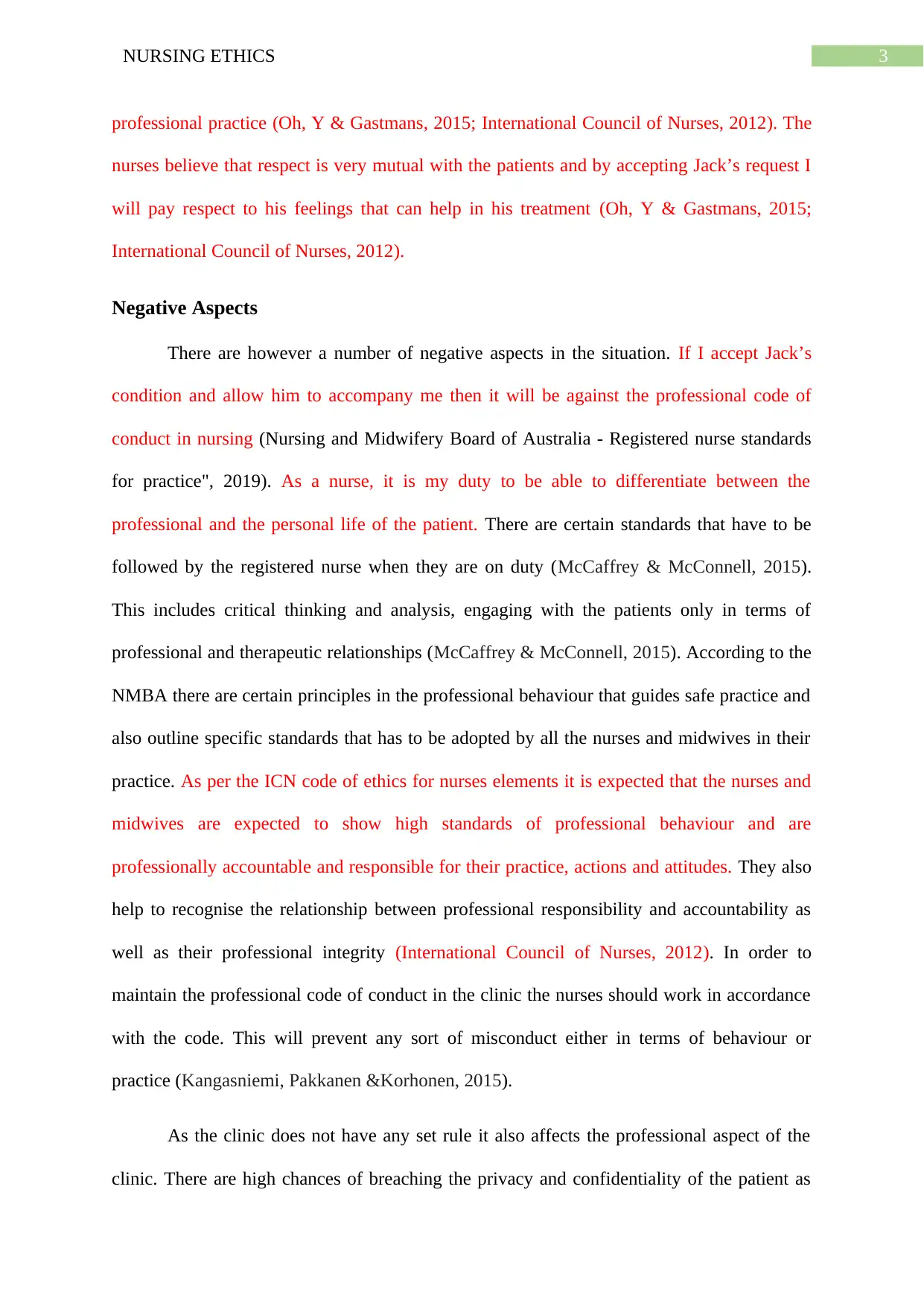
3NURSING ETHICS
professional practice (Oh, Y & Gastmans, 2015; International Council of Nurses, 2012). The
nurses believe that respect is very mutual with the patients and by accepting Jack’s request I
will pay respect to his feelings that can help in his treatment (Oh, Y & Gastmans, 2015;
International Council of Nurses, 2012).
Negative Aspects
There are however a number of negative aspects in the situation. If I accept Jack’s
condition and allow him to accompany me then it will be against the professional code of
conduct in nursing (Nursing and Midwifery Board of Australia - Registered nurse standards
for practice", 2019). As a nurse, it is my duty to be able to differentiate between the
professional and the personal life of the patient. There are certain standards that have to be
followed by the registered nurse when they are on duty (McCaffrey & McConnell, 2015).
This includes critical thinking and analysis, engaging with the patients only in terms of
professional and therapeutic relationships (McCaffrey & McConnell, 2015). According to the
NMBA there are certain principles in the professional behaviour that guides safe practice and
also outline specific standards that has to be adopted by all the nurses and midwives in their
practice. As per the ICN code of ethics for nurses elements it is expected that the nurses and
midwives are expected to show high standards of professional behaviour and are
professionally accountable and responsible for their practice, actions and attitudes. They also
help to recognise the relationship between professional responsibility and accountability as
well as their professional integrity (International Council of Nurses, 2012). In order to
maintain the professional code of conduct in the clinic the nurses should work in accordance
with the code. This will prevent any sort of misconduct either in terms of behaviour or
practice (Kangasniemi, Pakkanen &Korhonen, 2015).
As the clinic does not have any set rule it also affects the professional aspect of the
clinic. There are high chances of breaching the privacy and confidentiality of the patient as
professional practice (Oh, Y & Gastmans, 2015; International Council of Nurses, 2012). The
nurses believe that respect is very mutual with the patients and by accepting Jack’s request I
will pay respect to his feelings that can help in his treatment (Oh, Y & Gastmans, 2015;
International Council of Nurses, 2012).
Negative Aspects
There are however a number of negative aspects in the situation. If I accept Jack’s
condition and allow him to accompany me then it will be against the professional code of
conduct in nursing (Nursing and Midwifery Board of Australia - Registered nurse standards
for practice", 2019). As a nurse, it is my duty to be able to differentiate between the
professional and the personal life of the patient. There are certain standards that have to be
followed by the registered nurse when they are on duty (McCaffrey & McConnell, 2015).
This includes critical thinking and analysis, engaging with the patients only in terms of
professional and therapeutic relationships (McCaffrey & McConnell, 2015). According to the
NMBA there are certain principles in the professional behaviour that guides safe practice and
also outline specific standards that has to be adopted by all the nurses and midwives in their
practice. As per the ICN code of ethics for nurses elements it is expected that the nurses and
midwives are expected to show high standards of professional behaviour and are
professionally accountable and responsible for their practice, actions and attitudes. They also
help to recognise the relationship between professional responsibility and accountability as
well as their professional integrity (International Council of Nurses, 2012). In order to
maintain the professional code of conduct in the clinic the nurses should work in accordance
with the code. This will prevent any sort of misconduct either in terms of behaviour or
practice (Kangasniemi, Pakkanen &Korhonen, 2015).
As the clinic does not have any set rule it also affects the professional aspect of the
clinic. There are high chances of breaching the privacy and confidentiality of the patient as
Paraphrase This Document
Need a fresh take? Get an instant paraphrase of this document with our AI Paraphraser
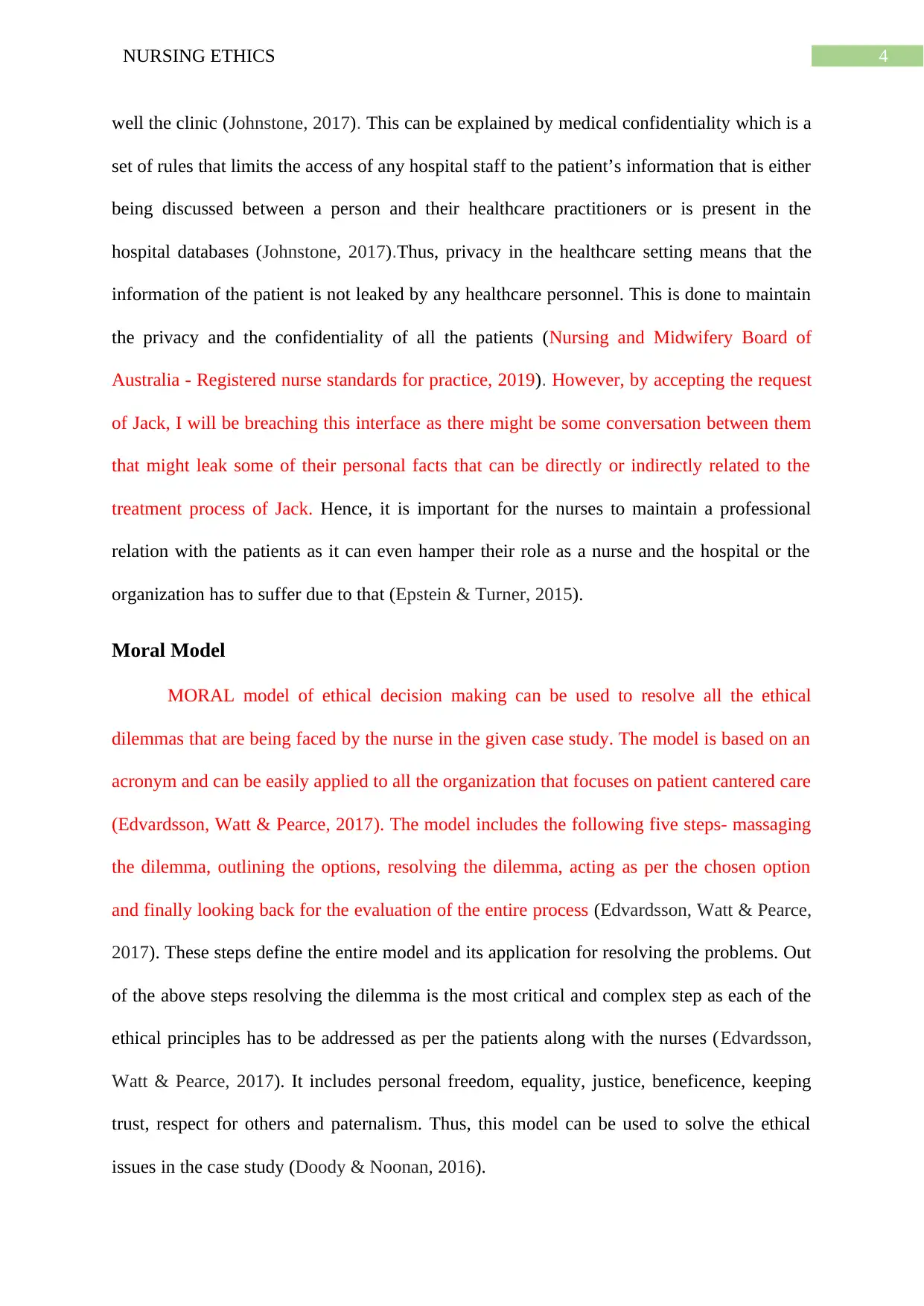
4NURSING ETHICS
well the clinic (Johnstone, 2017). This can be explained by medical confidentiality which is a
set of rules that limits the access of any hospital staff to the patient’s information that is either
being discussed between a person and their healthcare practitioners or is present in the
hospital databases (Johnstone, 2017).Thus, privacy in the healthcare setting means that the
information of the patient is not leaked by any healthcare personnel. This is done to maintain
the privacy and the confidentiality of all the patients (Nursing and Midwifery Board of
Australia - Registered nurse standards for practice, 2019). However, by accepting the request
of Jack, I will be breaching this interface as there might be some conversation between them
that might leak some of their personal facts that can be directly or indirectly related to the
treatment process of Jack. Hence, it is important for the nurses to maintain a professional
relation with the patients as it can even hamper their role as a nurse and the hospital or the
organization has to suffer due to that (Epstein & Turner, 2015).
Moral Model
MORAL model of ethical decision making can be used to resolve all the ethical
dilemmas that are being faced by the nurse in the given case study. The model is based on an
acronym and can be easily applied to all the organization that focuses on patient cantered care
(Edvardsson, Watt & Pearce, 2017). The model includes the following five steps- massaging
the dilemma, outlining the options, resolving the dilemma, acting as per the chosen option
and finally looking back for the evaluation of the entire process (Edvardsson, Watt & Pearce,
2017). These steps define the entire model and its application for resolving the problems. Out
of the above steps resolving the dilemma is the most critical and complex step as each of the
ethical principles has to be addressed as per the patients along with the nurses (Edvardsson,
Watt & Pearce, 2017). It includes personal freedom, equality, justice, beneficence, keeping
trust, respect for others and paternalism. Thus, this model can be used to solve the ethical
issues in the case study (Doody & Noonan, 2016).
well the clinic (Johnstone, 2017). This can be explained by medical confidentiality which is a
set of rules that limits the access of any hospital staff to the patient’s information that is either
being discussed between a person and their healthcare practitioners or is present in the
hospital databases (Johnstone, 2017).Thus, privacy in the healthcare setting means that the
information of the patient is not leaked by any healthcare personnel. This is done to maintain
the privacy and the confidentiality of all the patients (Nursing and Midwifery Board of
Australia - Registered nurse standards for practice, 2019). However, by accepting the request
of Jack, I will be breaching this interface as there might be some conversation between them
that might leak some of their personal facts that can be directly or indirectly related to the
treatment process of Jack. Hence, it is important for the nurses to maintain a professional
relation with the patients as it can even hamper their role as a nurse and the hospital or the
organization has to suffer due to that (Epstein & Turner, 2015).
Moral Model
MORAL model of ethical decision making can be used to resolve all the ethical
dilemmas that are being faced by the nurse in the given case study. The model is based on an
acronym and can be easily applied to all the organization that focuses on patient cantered care
(Edvardsson, Watt & Pearce, 2017). The model includes the following five steps- massaging
the dilemma, outlining the options, resolving the dilemma, acting as per the chosen option
and finally looking back for the evaluation of the entire process (Edvardsson, Watt & Pearce,
2017). These steps define the entire model and its application for resolving the problems. Out
of the above steps resolving the dilemma is the most critical and complex step as each of the
ethical principles has to be addressed as per the patients along with the nurses (Edvardsson,
Watt & Pearce, 2017). It includes personal freedom, equality, justice, beneficence, keeping
trust, respect for others and paternalism. Thus, this model can be used to solve the ethical
issues in the case study (Doody & Noonan, 2016).
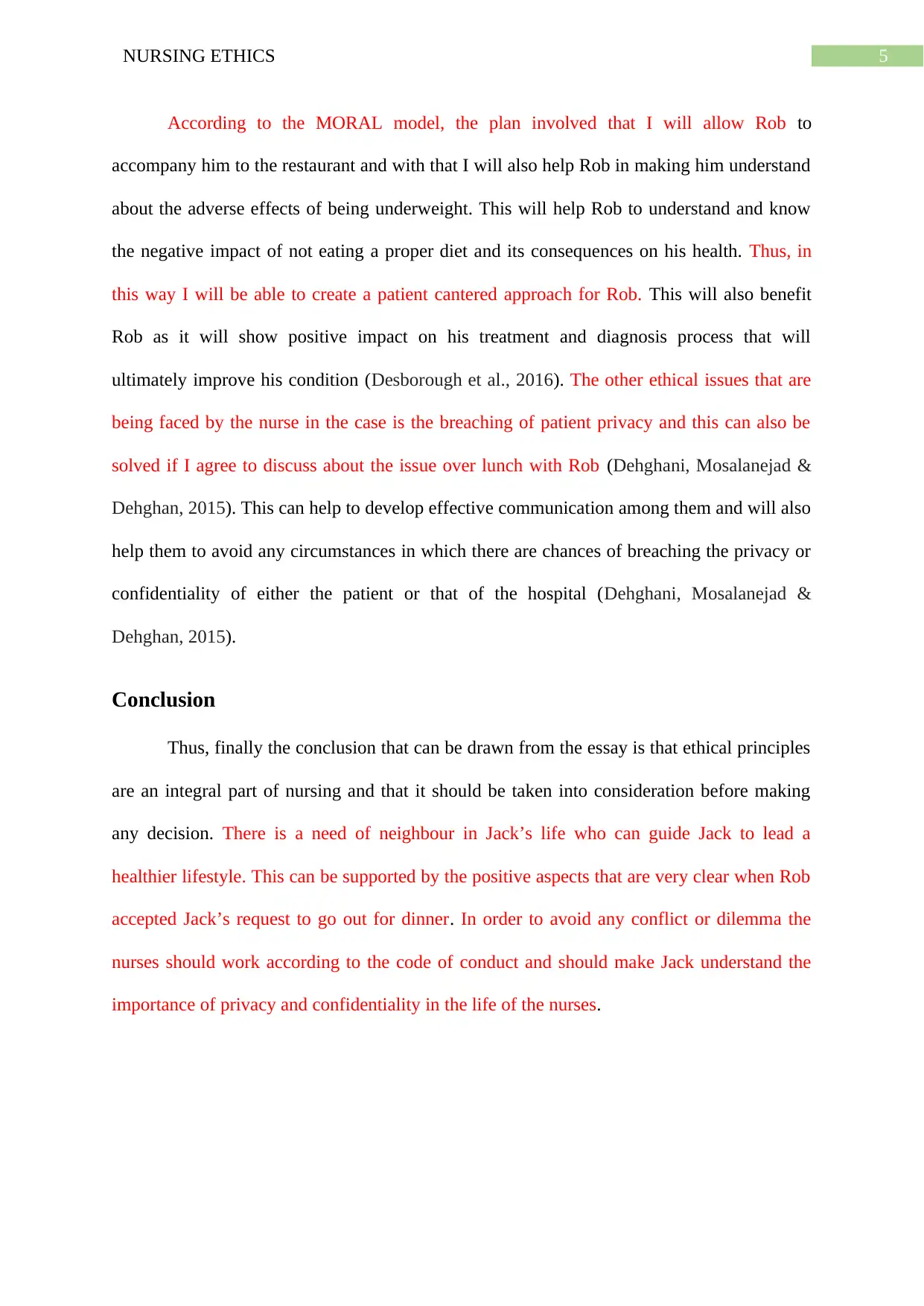
5NURSING ETHICS
According to the MORAL model, the plan involved that I will allow Rob to
accompany him to the restaurant and with that I will also help Rob in making him understand
about the adverse effects of being underweight. This will help Rob to understand and know
the negative impact of not eating a proper diet and its consequences on his health. Thus, in
this way I will be able to create a patient cantered approach for Rob. This will also benefit
Rob as it will show positive impact on his treatment and diagnosis process that will
ultimately improve his condition (Desborough et al., 2016). The other ethical issues that are
being faced by the nurse in the case is the breaching of patient privacy and this can also be
solved if I agree to discuss about the issue over lunch with Rob (Dehghani, Mosalanejad &
Dehghan, 2015). This can help to develop effective communication among them and will also
help them to avoid any circumstances in which there are chances of breaching the privacy or
confidentiality of either the patient or that of the hospital (Dehghani, Mosalanejad &
Dehghan, 2015).
Conclusion
Thus, finally the conclusion that can be drawn from the essay is that ethical principles
are an integral part of nursing and that it should be taken into consideration before making
any decision. There is a need of neighbour in Jack’s life who can guide Jack to lead a
healthier lifestyle. This can be supported by the positive aspects that are very clear when Rob
accepted Jack’s request to go out for dinner. In order to avoid any conflict or dilemma the
nurses should work according to the code of conduct and should make Jack understand the
importance of privacy and confidentiality in the life of the nurses.
According to the MORAL model, the plan involved that I will allow Rob to
accompany him to the restaurant and with that I will also help Rob in making him understand
about the adverse effects of being underweight. This will help Rob to understand and know
the negative impact of not eating a proper diet and its consequences on his health. Thus, in
this way I will be able to create a patient cantered approach for Rob. This will also benefit
Rob as it will show positive impact on his treatment and diagnosis process that will
ultimately improve his condition (Desborough et al., 2016). The other ethical issues that are
being faced by the nurse in the case is the breaching of patient privacy and this can also be
solved if I agree to discuss about the issue over lunch with Rob (Dehghani, Mosalanejad &
Dehghan, 2015). This can help to develop effective communication among them and will also
help them to avoid any circumstances in which there are chances of breaching the privacy or
confidentiality of either the patient or that of the hospital (Dehghani, Mosalanejad &
Dehghan, 2015).
Conclusion
Thus, finally the conclusion that can be drawn from the essay is that ethical principles
are an integral part of nursing and that it should be taken into consideration before making
any decision. There is a need of neighbour in Jack’s life who can guide Jack to lead a
healthier lifestyle. This can be supported by the positive aspects that are very clear when Rob
accepted Jack’s request to go out for dinner. In order to avoid any conflict or dilemma the
nurses should work according to the code of conduct and should make Jack understand the
importance of privacy and confidentiality in the life of the nurses.
⊘ This is a preview!⊘
Do you want full access?
Subscribe today to unlock all pages.

Trusted by 1+ million students worldwide
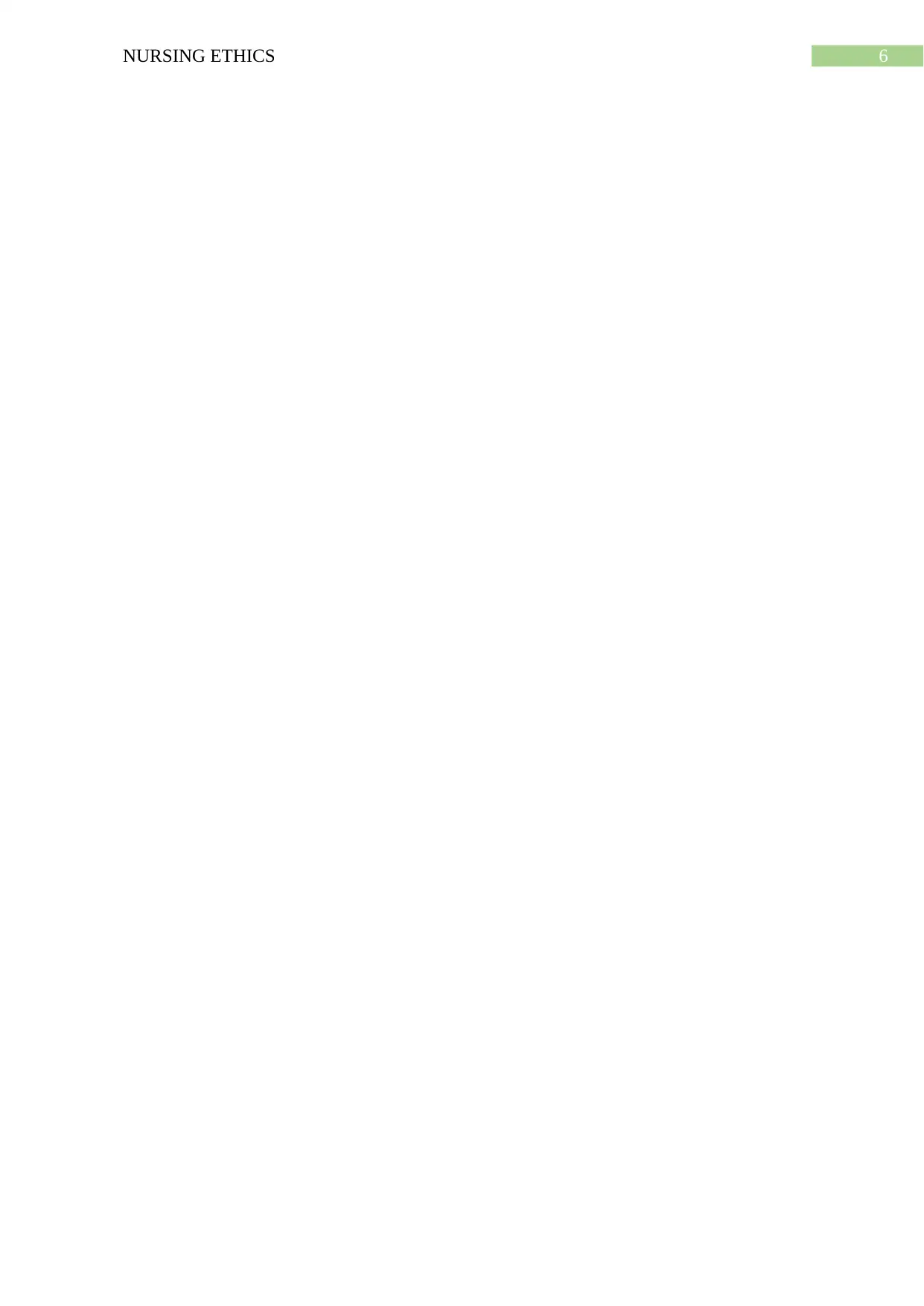
6NURSING ETHICS
Paraphrase This Document
Need a fresh take? Get an instant paraphrase of this document with our AI Paraphraser
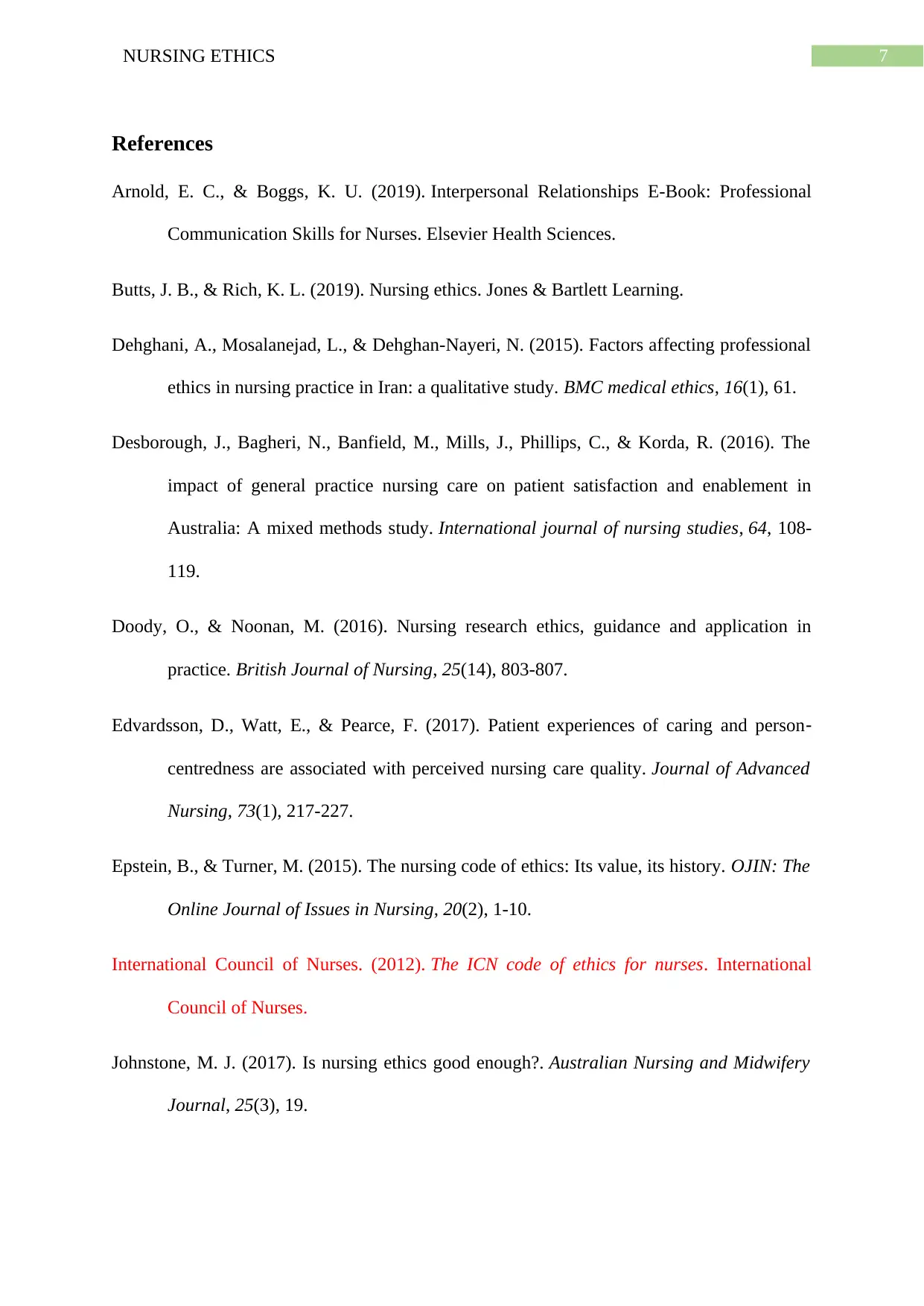
7NURSING ETHICS
References
Arnold, E. C., & Boggs, K. U. (2019). Interpersonal Relationships E-Book: Professional
Communication Skills for Nurses. Elsevier Health Sciences.
Butts, J. B., & Rich, K. L. (2019). Nursing ethics. Jones & Bartlett Learning.
Dehghani, A., Mosalanejad, L., & Dehghan-Nayeri, N. (2015). Factors affecting professional
ethics in nursing practice in Iran: a qualitative study. BMC medical ethics, 16(1), 61.
Desborough, J., Bagheri, N., Banfield, M., Mills, J., Phillips, C., & Korda, R. (2016). The
impact of general practice nursing care on patient satisfaction and enablement in
Australia: A mixed methods study. International journal of nursing studies, 64, 108-
119.
Doody, O., & Noonan, M. (2016). Nursing research ethics, guidance and application in
practice. British Journal of Nursing, 25(14), 803-807.
Edvardsson, D., Watt, E., & Pearce, F. (2017). Patient experiences of caring and person‐
centredness are associated with perceived nursing care quality. Journal of Advanced
Nursing, 73(1), 217-227.
Epstein, B., & Turner, M. (2015). The nursing code of ethics: Its value, its history. OJIN: The
Online Journal of Issues in Nursing, 20(2), 1-10.
International Council of Nurses. (2012). The ICN code of ethics for nurses. International
Council of Nurses.
Johnstone, M. J. (2017). Is nursing ethics good enough?. Australian Nursing and Midwifery
Journal, 25(3), 19.
References
Arnold, E. C., & Boggs, K. U. (2019). Interpersonal Relationships E-Book: Professional
Communication Skills for Nurses. Elsevier Health Sciences.
Butts, J. B., & Rich, K. L. (2019). Nursing ethics. Jones & Bartlett Learning.
Dehghani, A., Mosalanejad, L., & Dehghan-Nayeri, N. (2015). Factors affecting professional
ethics in nursing practice in Iran: a qualitative study. BMC medical ethics, 16(1), 61.
Desborough, J., Bagheri, N., Banfield, M., Mills, J., Phillips, C., & Korda, R. (2016). The
impact of general practice nursing care on patient satisfaction and enablement in
Australia: A mixed methods study. International journal of nursing studies, 64, 108-
119.
Doody, O., & Noonan, M. (2016). Nursing research ethics, guidance and application in
practice. British Journal of Nursing, 25(14), 803-807.
Edvardsson, D., Watt, E., & Pearce, F. (2017). Patient experiences of caring and person‐
centredness are associated with perceived nursing care quality. Journal of Advanced
Nursing, 73(1), 217-227.
Epstein, B., & Turner, M. (2015). The nursing code of ethics: Its value, its history. OJIN: The
Online Journal of Issues in Nursing, 20(2), 1-10.
International Council of Nurses. (2012). The ICN code of ethics for nurses. International
Council of Nurses.
Johnstone, M. J. (2017). Is nursing ethics good enough?. Australian Nursing and Midwifery
Journal, 25(3), 19.
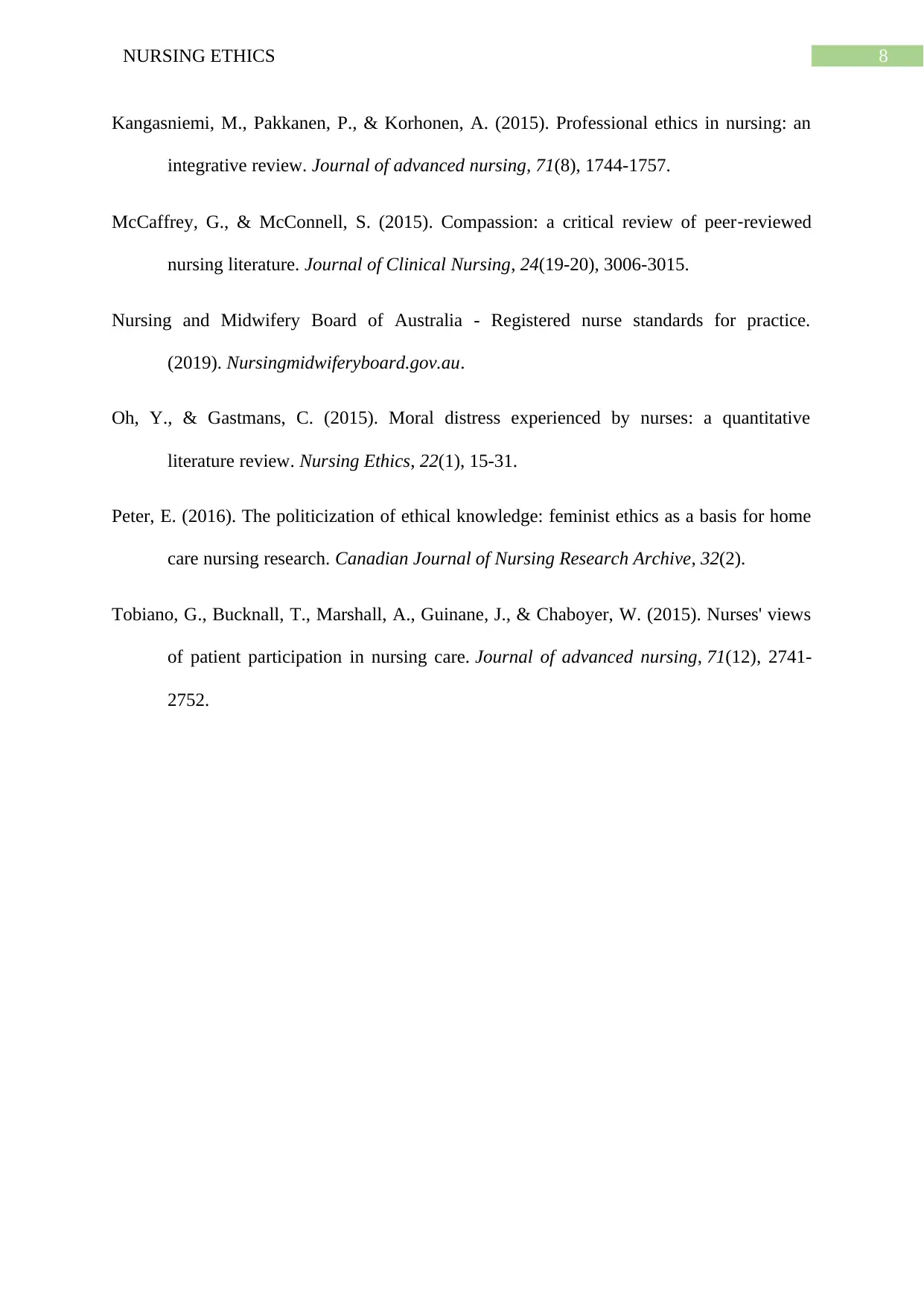
8NURSING ETHICS
Kangasniemi, M., Pakkanen, P., & Korhonen, A. (2015). Professional ethics in nursing: an
integrative review. Journal of advanced nursing, 71(8), 1744-1757.
McCaffrey, G., & McConnell, S. (2015). Compassion: a critical review of peer‐reviewed
nursing literature. Journal of Clinical Nursing, 24(19-20), 3006-3015.
Nursing and Midwifery Board of Australia - Registered nurse standards for practice.
(2019). Nursingmidwiferyboard.gov.au.
Oh, Y., & Gastmans, C. (2015). Moral distress experienced by nurses: a quantitative
literature review. Nursing Ethics, 22(1), 15-31.
Peter, E. (2016). The politicization of ethical knowledge: feminist ethics as a basis for home
care nursing research. Canadian Journal of Nursing Research Archive, 32(2).
Tobiano, G., Bucknall, T., Marshall, A., Guinane, J., & Chaboyer, W. (2015). Nurses' views
of patient participation in nursing care. Journal of advanced nursing, 71(12), 2741-
2752.
Kangasniemi, M., Pakkanen, P., & Korhonen, A. (2015). Professional ethics in nursing: an
integrative review. Journal of advanced nursing, 71(8), 1744-1757.
McCaffrey, G., & McConnell, S. (2015). Compassion: a critical review of peer‐reviewed
nursing literature. Journal of Clinical Nursing, 24(19-20), 3006-3015.
Nursing and Midwifery Board of Australia - Registered nurse standards for practice.
(2019). Nursingmidwiferyboard.gov.au.
Oh, Y., & Gastmans, C. (2015). Moral distress experienced by nurses: a quantitative
literature review. Nursing Ethics, 22(1), 15-31.
Peter, E. (2016). The politicization of ethical knowledge: feminist ethics as a basis for home
care nursing research. Canadian Journal of Nursing Research Archive, 32(2).
Tobiano, G., Bucknall, T., Marshall, A., Guinane, J., & Chaboyer, W. (2015). Nurses' views
of patient participation in nursing care. Journal of advanced nursing, 71(12), 2741-
2752.
⊘ This is a preview!⊘
Do you want full access?
Subscribe today to unlock all pages.

Trusted by 1+ million students worldwide
1 out of 9
Related Documents
Your All-in-One AI-Powered Toolkit for Academic Success.
+13062052269
info@desklib.com
Available 24*7 on WhatsApp / Email
![[object Object]](/_next/static/media/star-bottom.7253800d.svg)
Unlock your academic potential
Copyright © 2020–2025 A2Z Services. All Rights Reserved. Developed and managed by ZUCOL.





